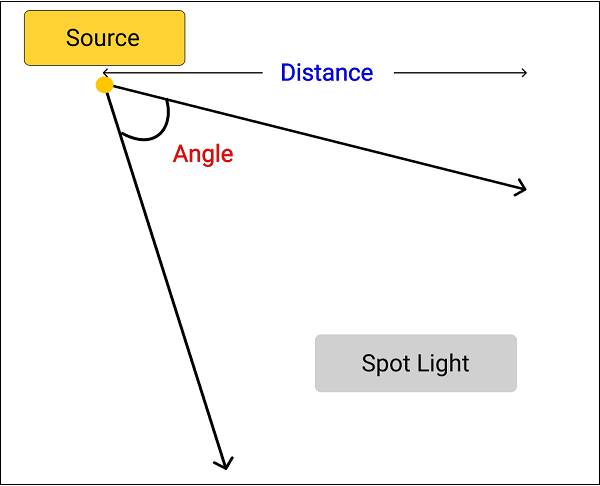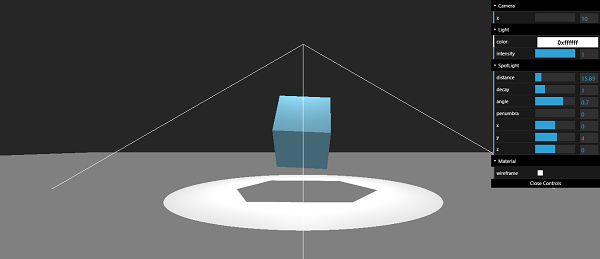
- Three.js - Home
- Three.js - Introduction
- Three.js - Installation
- Three.js - Hello Cube App
- Three.js - Renderer and Responsiveness
- Three.js - Responsive Design
- Three.js - Debug and Stats
- Three.js - Cameras
- Three.js - Controls
- Three.js - Lights & Shadows
- Three.js - Geometries
- Three.js - Materials
- Three.js - Textures
- Three.js - Drawing Lines
- Three.js - Animations
- Three.js - Creating Text
- Three.js - Loading 3D Models
- Three.js - Libraries and Plugins
- Three.js Useful Resources
- Three.js - Quick Guide
- Three.js - Useful Resources
- Three.js - Discussion
Three.js - Spotlight
It is another kind of light that comes from a specific direction in the shape of the cone.
distance − Maximum range of the light. Default is 0 (no limit).
angle − Maximum angle of light dispersion from its direction whose upper bound is Math.PI/2.
penumbra − Percent of the spotlight cone attenuates due to penumbra. It takes values between zero and 1. Default is 0.
decay − The amount the light dims along with the distance of the light.

const light = new THREE.SpotLight(color, intensity) light.position.set(1, 10, 10) light.castShadow = true light.shadow.camera.near = 5 light.shadow.camera.far = 400 light.shadow.camera.fov = 30
The shadow.camera.near, shadow.camera.far, and shadow.camera.fov properties define the area where shadows can appear.
Check out the following example.
Example
spotlight.html
<!DOCTYPE html>
<html lang="en">
<head>
<meta charset="UTF-8" />
<meta http-equiv="X-UA-Compatible" content="ie=edge" />
<meta name="viewport" content="width=device-width, initial-scale=1.0" />
<title>Three.js - SpotLight</title>
<style>
* {
margin: 0;
padding: 0;
box-sizing: border-box;
font-family: -applesystem, BlinkMacSystemFont, 'Segoe UI', Roboto, Oxygen, Ubuntu,
Cantarell, 'Open Sans', 'Helvetica Neue', sans-serif;
}
html,
body {
height: 100vh;
width: 100vw;
}
#threejs-container {
position: block;
width: 100%;
height: 100%;
}
</style>
<script src="https://cdnjs.cloudflare.com/ajax/libs/three.js/r128/three.min.js"></script>
<script src="https://cdnjs.cloudflare.com/ajax/libs/dat-gui/0.7.7/dat.gui.js"></script>
</head>
<body>
<div id="container"></div>
<script type="module">
// Adding spotlight in Three.js
// You can control the properties of light using the GUI
// You can see the position and the cone of light in this example
// GUI
const gui = new dat.GUI()
// sizes
const width = window.innerWidth
const height = window.innerHeight
// scene
const scene = new THREE.Scene()
scene.background = new THREE.Color(0x262626)
console.log(scene.children)
// camera
const camera = new THREE.PerspectiveCamera(60, width / height, 0.1, 1000)
camera.position.set(0, 0, 10)
const camFolder = gui.addFolder('Camera')
camFolder.add(camera.position, 'z', 10, 80, 1)
camFolder.open()
// lights
const ambientLight = new THREE.AmbientLight(0xffffff, 0.5)
scene.add(ambientLight)
const light = new THREE.SpotLight()
light.position.set(0, 5, 0)
// for shadow
light.castShadow = true
light.shadow.mapSize.width = 1024
light.shadow.mapSize.height = 1024
light.shadow.camera.near = 0.5
light.shadow.camera.far = 100
scene.add(light)
const helper = new THREE.SpotLightHelper(light)
scene.add(helper)
// light controls
const lightColor = {
color: light.color.getHex()
}
const lightFolder = gui.addFolder('Light')
lightFolder.addColor(lightColor, 'color').onChange(() => {
light.color.set(lightColor.color)
})
lightFolder.add(light, 'intensity', 0, 1, 0.01)
lightFolder.open()
const spotLightFolder = gui.addFolder('SpotLight')
spotLightFolder.add(light, 'distance', 0, 100, 0.01)
spotLightFolder.add(light, 'decay', 0, 4, 0.1)
spotLightFolder.add(light, 'angle', 0, 1, 0.1)
spotLightFolder.add(light, 'penumbra', 0, 1, 0.1)
spotLightFolder.add(light.position, 'x', -50, 50, 1)
spotLightFolder.add(light.position, 'y', -50, 50, 1)
spotLightFolder.add(light.position, 'z', -50, 50, 1)
spotLightFolder.open()
// plane
const planeGeometry = new THREE.PlaneGeometry(100, 100)
const plane = new THREE.Mesh(planeGeometry, new THREE.MeshPhongMateria
l({ color: 0xffffff }))
plane.rotateX(-Math.PI / 2)
plane.position.y = -1.75
plane.receiveShadow = true
scene.add(plane)
// cube
const geometry = new THREE.BoxGeometry(2, 2, 2)
const material = new THREE.MeshStandardMaterial({
color: 0x87ceeb
})
const materialFolder = gui.addFolder('Material')
materialFolder.add(material, 'wireframe')
materialFolder.open()
const cube = new THREE.Mesh(geometry, material)
cube.position.set(0, 0.5, 0)
cube.castShadow = true
cube.receiveShadow = true
scene.add(cube)
// responsiveness
window.addEventListener('resize', () => {
width = window.innerWidth
height = window.innerHeight
camera.aspect = width / height
camera.updateProjectionMatrix()
renderer.setSize(window.innerWidth, window.innerHeight)
renderer.render(scene, camera)
})
// renderer
const renderer = new THREE.WebGL1Renderer()
renderer.setSize(window.innerWidth, window.innerHeight)
renderer.shadowMap.enabled = true
renderer.shadowMap.type = THREE.PCFSoftShadowMap
renderer.setPixelRatio(Math.min(window.devicePixelRatio, 2))
// animation
function animate() {
requestAnimationFrame(animate)
cube.rotation.x += 0.005
cube.rotation.y += 0.01
renderer.render(scene, camera)
}
// rendering the scene
const container = document.querySelector('#container')
container.append(renderer.domElement)
renderer.render(scene, camera)
animate()
</script>
</body>
</html>
Output

threejs_lights_and_shadows.htm
Advertisements